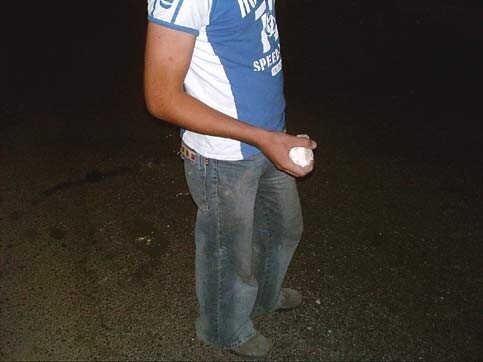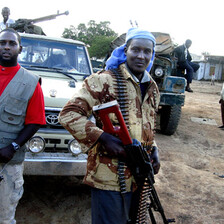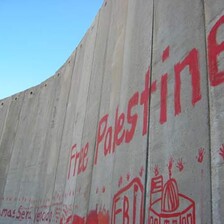Birzeit 14 July 2005

The morning after: remnants of street barricades in Birzeit. (Anonymous)
Over the past two days, the international media has followed Israel’s hunt for the culprits of the Netanya suicide bombing, the first such attack in five months, with fawning deference to the reports of “military officials” and “Israeli authorities.” Today, for instance, the Los Angeles Times’ Henry Chu reported that “Israeli forces backed by attack helicopters and armored vehicles pushed into the West Bank city of Tulkarm and arrested several suspected militants.” Although it makes an easier read if Mr. Chu’s audience can imagine a Battle of the Bulge scenario, where embattled Israeli forces put US tax dollars to use in their struggle against “terrorists,” it might be worthwhile to offer some details on the ground - particularly in the areas where conflict is hardly expected.
On Wednesday night, the relative tranquillity of Birzeit came to an end when two unmarked armoured jeeps rolled lazily into the town center. Three Israeli commandos emerged from one of the vehicles and entered a corner store. “What are you people doing in Birzeit?” the shopkeeper asked. “We’ve come to fight for Israel,” a soldier responded.
Although Birzeit is a peaceful village of approximately 5,000 farmers, storekeepers and university students in the hills north of Ramallah, the arrival of the Israeli convoy wasn’t a complete surprise. On the previous night, Israeli incursions were visible in the Jalazun refugee camp, which sits on a hill less than a mile east of Birzeit, as gunfire and grenade explosions erupted across the valley. Similar sounds could be heard concurrently in villages to the west of Birzeit. Earlier on Wednesday, according to a local business owner, Israeli troops visited the home of a “suspected militant” in Birzeit, but no one was found.
But as events unfolded on Wednesday night, it quickly became evident that the logic behind this visit was, to put it generously, contrived. With no apparent fight to be found in Birzeit, the Israelis implemented a highly sophisticated military strategy that we will, for now, call Operation Drive Around Like A Bunch Of Teenagers At A Taco Bell Parking Lot, or Operation Drive Around (ODA) for short.
Here is how ODA works: the aforementioned jeeps started by moving about slowly, their drunken yellow emergency lights pulsing on the walls of buildings for all to see. The primary objectives of this phase entailed circling busy intersections and ferociously accelerating at the sight of pedestrians. Since these tactics only drew the ire of immediate observers, the soldiers set off a sound grenade, so as not to exclude anyone from the desired fracas.

About a dozen young men threw stones at the jeeps as they made their passes. (Anonymous)
Unbeknownst to the many in the Western World, most Palestinians are averse to being run over by jeeps, or to having their evenings disturbed by the illegal presence of colonial military units. This may explain why, within minutes, Wednesday night’s ODA developed into a mild conflict. It started with about a dozen young men throwing stones at the jeeps as they made their passes. The stones, even when hurled from a meter’s distance, bounced harmlessly from the vehicles’ fortified steel and Plexiglass windows. The drivers of the jeeps didn’t seem to mind as they idled on blind street corners where youths gathered with handfuls of projectiles.
For the next two hours, a cat and mouse pattern developed, with some minor escalations. The number of stone throwers doubled, and implemented their own strategies of barricading roadways with dumpsters and cinder blocks. A handful of international students loitered outside of a restaurant with digital cameras. One of the soldiers took the photo opportunity to swagger from the jeep while cocking his laser-sited M4 with Hollywood panache. Two more soldiers followed him with similar histrionics, as the team supposedly “cleared an area” that stone-throwers had long since vacated. The chase resumed until one of the jeeps took a direct - yet harmless - hit from a Molotov cocktail, which drew applause from the small crowd that had gathered. At 11:00 PM, the Israeli patrol finally lurched away scarred, smouldering but more or less intact.
Although witnesses would embellish on the incident the next day, Birzeit’s residents did not take it lightly. Civilian deaths are incurred in West Bank villages on a weekly basis, even where protests take a decidedly non-violent route. Last Friday, a 15-year-old was killed during a peaceful demonstration in Bil’in against the construction of Israel’s Apartheid Wall. One week ago, 14-year-old Noor Faris Njem was killed when Israeli soldiers opened fire on unarmed civilians in the Balata Refugee Camp.
Throughout Wednesday night’s ODA, two ambulances stood by on the scene. A sad combination worry and fatigue colored the faces of their drivers - elderly volunteers called from their homes late at night - as they waited for the episode to end.
“What kind of army does this?” a shopkeeper told me. “There is no conflict here. Why do they waste their time and money looking for one?”
On the following day, I recognized some of the previous night’s stone throwers at a local billiard hall. For some, the incident had become a springboard for machismo taunting: So-and-so can’t throw a stone to save his life; did you see the way that he ran from the jeep?
As is often the case, the humor was a matter of coping with life under occupation. “All of us are scared,” one of my friends intimated to me as we walked back from the pool hall together. He produced his cellular phone to show me a text message that he received from his girlfriend that night. It read: “Plz go home habibi.* dont be crazy. if u love me, plz go home.”
* Arabic for “my love.”
Zachary Wales is a masters student at Columbia University’s School of International and Public Affairs. He is also a co-founder of Labor for Palestine, and he currently takes summer courses at Birzeit University.





